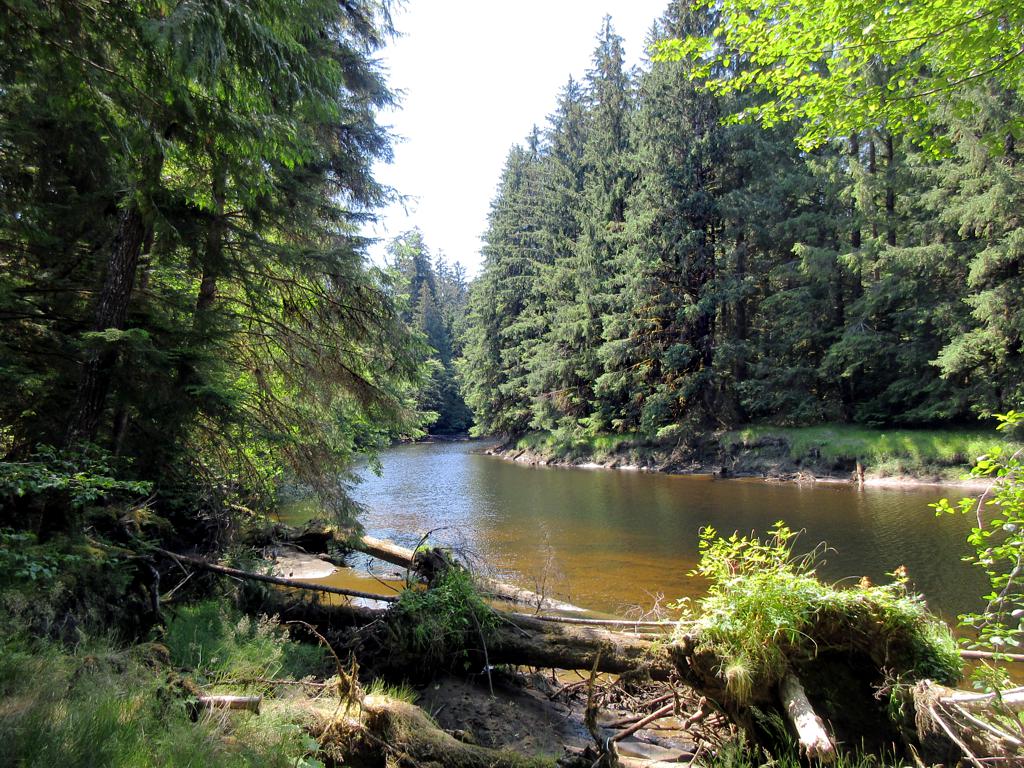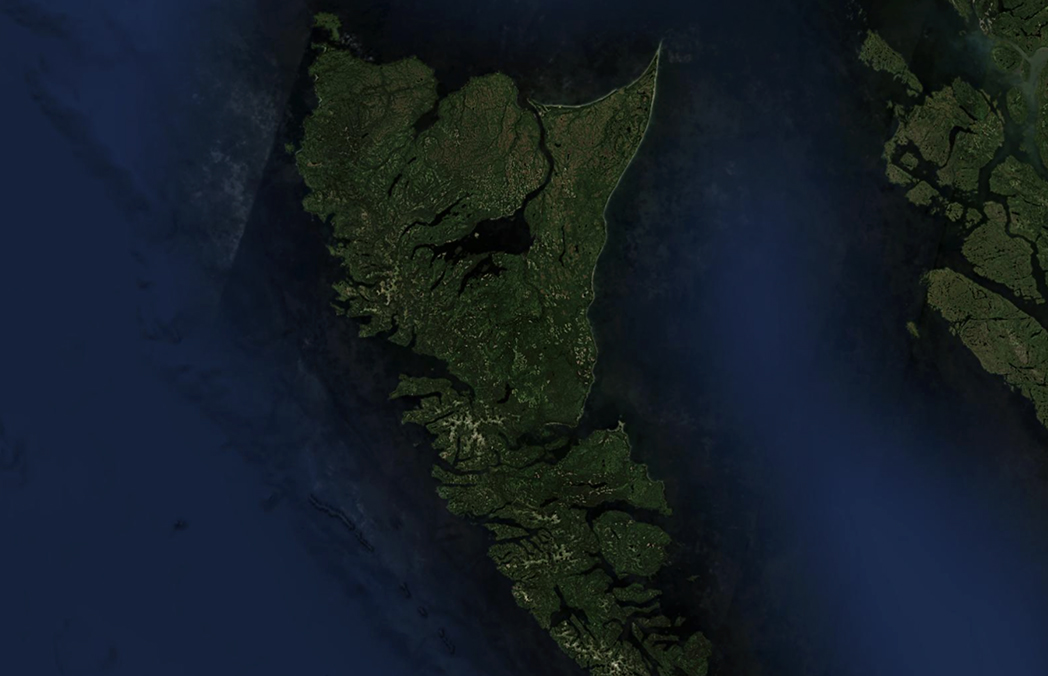A mining company and a former B.C. premier say a gold mine worth $3.5 billion could be built near the Yakoun River with Haida ownership and no harm to the watershed.
JDS Mining is the latest in a series of companies to own claims to a gold deposit near the Yakoun River south of Port Clements.
“I think the leadership and the people of the island need to be fully aware of what the opportunities are,” says Jeff Stibbard, a mining engineer who is the CEO and founder of Vancouver-based JDS Mining.
“If it’s not the will of the people, it’s not something we want to push forward.”
The Haida Gwaii News asked the Council of the Haida Nation (CHN) for comment, but did not receive a response by press time.
First staked by a logger in 1970, the gold deposit on Graham Island was explored by diamond drillers up until the late 1990s. More work is needed to confirm its potential.
Australian mining company City Resources once proposed building the Cinola Gold mine for the same deposit. In 1989, then CHN President Miles Richardson said Haida people had decided there will be no gold mining in the Yakoun River watershed.
A major concern was that tailings leaks or acid-rock drainage could ruin the Yakoun, Haida Gwaii’s longest and most productive river.
In 1981, a pilot mill testing ore for Cinola had a tailings leak, though no fish kill was reported.
City Resources spent $30 million trying to develop Cinola but gave up after a 1990 review showed it wasn’t worth it given gold prices at the time.
Renamed Harmony Gold, the claims passed to Misty Mountain Gold in 1995, to Taseko Mines in 2001, and to JDS Gold in 2021.
Jeff Stibbard founded JDS Mining in 2004 after 20 years in various roles at major mining firms.
From the outset, Stibbard said JDS has built mines in partnership with Indigenous peoples.
The company has worked with the Fort McKay, Liard, Kaska Dena, Na-Cho Nyak Dun, Selkirk, Shishalh, Tahltan, Kwadache and Little Salmon Carmacks First Nations.
Before he started JDS, Stibbard said he spent 20 years in various roles at major mining firms, learning the whole chain of exploring, to developing and closing mines.
He first became familiar with the Cinola project as a diamond driller on Haida Gwaii in 1983.
But while the deposit is the same, Stibbard said the mine and the Haida Nation partnership JDS is proposing now is nothing like the Cinola project of 40 years ago.
“That’s when things went off the rails,” he said, calling City Resources’ approach unacceptable.
“It would have caused us more problems with respect to getting buy-in to mining, not only from the Haida but across the country,” he said.
“It failed for the right reasons, I think.”

(David Stanley photo)
Today, Stibbard said a gold mine could be built with no tailings ponds, no dammed creeks, no cyanide leaching, and no air-polluting process to roast the ore, which carries a risk of lead and mercury contamination.
Instead, Stibbard said recent technology allows the ore to be crushed, and the gold concentrated with a water-based process until it is about three-quarters pure. A similar process is used at the Brucejack Gold Mine near Stewart, B.C.
The final process to extract pure gold from the ore would be done at a specialized smelter abroad, most likely in Japan, which has gold deposits similar to the one on Graham Island.
“It’s more costly obviously, because you have to ship the material off-site for final processing,” said Stibbard. “But the cost benefit is worth it — you eliminate that whole cyanide process.”
Instead of leaving a slurry of tailings, Stibbard said the crushed rock left behind can be squeezed dry and stacked in piles similar to what people see at former gravel quarries.
Those piles could be seeded with plants as the mine develops, making it easier to close the mine at the end of its 20- or 25-year lifespan.
Stibbard said the gold deposit is not on steep terrain, making it relatively easy to access. And because it’s a rich deposit, the pit would be relatively small.
“You don’t have to open up a big huge hole in the ground and have huge material stockpiled to get the good stuff,” he said.
“It’s a high-grade formation.”
The mine would require a large power plant, one that the company says could replace Haida Gwaii’s diesel-fired generators with a less emitting technology.
So far, the most likely option seems to be a plant fired by a mix of wood waste and LNG. JDS has also looked at supplemental wind or solar power, and emerging large-scale battery systems.
Altogether, building the mine would cost roughly $2.5 billion to develop, Stibbard said, creating many opportunities for transport, trades and other spin-off businesses that would give people many more work opportunities on island and young people incentive to stay home.
At current gold prices, he said the mine could generate some $3.5 billion in value and be developed in a partnership agreement with the Haida Nation.
To put that in context, Stibbard said the revenues would eclipse all logging past and present on Haida Gwaii, and more revenue than all the currently undeveloped gold-mine operations across Canada.
Stibbard said that in all the years a mine has been proposed for this gold deposit on Haida Gwaii, people have never been presented the opportunity in a fair way.
Gordon Campbell, who served as B.C. premier from 2001 to 2011 and later as Canada’s high commissioner to the United Kingdom, has joined JDS Mining as an advisor on the Harmony Gold project.
When JDS approached him about the project a year and a half ago, Campbell said he admired the 21st-century approach to mining and to reconciliation.
“There will probably be 20 or 25 years of economic benefits,” Campbell said. “But the environmental benefits will be generational. The improvements to the Yakoun River and the streams are generational.”
Campbell said a highlight of his time as premier was when the Haida people returned the name Queen Charlotte Islands to him in a bentwood box, wiping it off the maps.
Campbell said after that experience, he recognizes the strong leadership the Haida have, and the difference that could make to the islands’ future.
Campbell said he has spoken only briefly about the project with Gaagwiis, Jason Alsop, president of the Council of the Haida Nation. JDS recently held a meeting on island with the Haida hereditary chiefs, but few attended.
“It’s for them to say to us, this is what’s important,” Campbell said.
“It’s very exciting to me, and if it’s exciting to the Haida people, that’s great. The ball is in their court.”
Asked if the Haida might cancel the mineral claims that the Harmony Gold project is based on, Campbell said, “I think the evidence is that they want to build a positive economic, social, and environmental future for Haida Gwaii.”
“The Haida Nation has always been a leader, and I think this is an opportunity for leadership.”
Stibbard said he recognizes that much of the CHN’s focus has been on Gaayhllxid Gíihlagalgang, the Haida Title Lands Agreement.
Now that the title agreement is secured, he said it could help make the Harmony Gold project a model for other First Nations across Canada.
“I’ve built a lot of mines around the country in conjunction with First Nations folks, and they’ve been very successful because of it,” he said. “I think the Haida can eclipse what’s been done in the past.”
“If we’re totally shunned, we’ll get the message,” he added later.
“But the opportunity is big. We want to speak to everyone there.”
